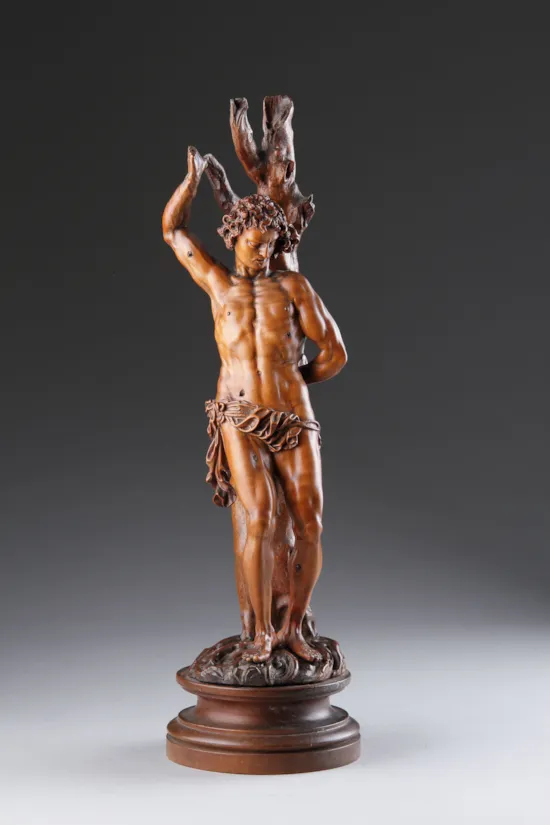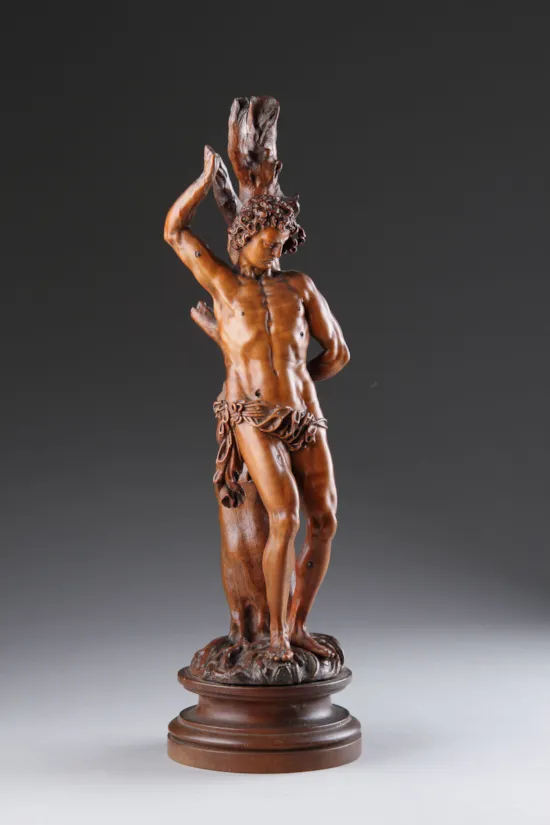South German Pear-wood Sculpture of Saint Sebastian Patron of Archers and Soldiers
A Fine South German Pear-wood Sculpture of Saint Sebastian Patron of Archers and Soldiers
Standing against a Naturalistically Carved Tree Trunk of Close Grained Oak
Refined and Detailed Facial Features a Moustache and Falling Locks of Curling Hair One Arm Outstretched the Other Behind his Back
A Monogram carved underneath the base ‘JC’ together with a Cross Pattée ☩
Arrows missing and top of right hand damaged
Early 17th Century
Size: 37cm high - 14½ ins high / base: 10.5cm dia. - 4¼ ins dia.
Standing against a Naturalistically Carved Tree Trunk of Close Grained Oak
Refined and Detailed Facial Features a Moustache and Falling Locks of Curling Hair One Arm Outstretched the Other Behind his Back
A Monogram carved underneath the base ‘JC’ together with a Cross Pattée ☩
Arrows missing and top of right hand damaged
Early 17th Century
Size: 37cm high - 14½ ins high / base: 10.5cm dia. - 4¼ ins dia.
According to legend Sebastian was an officer of the guard in ancient Rome and condemned to death by shooting with crossbow by the Emperor Diocletian in 288 A.D because he had preached and propagated his Christian beliefs in a seditious manner. Bombarded by arrows shot at close range, he was declared dead at his place of execution where he was tended by St Irene. He then miraculously recovered and confronted the Emperor for his cruelty. As a result he suffered his second martyrdom by means of being bludgeoned to death with cudgels. His body was thrown into the city sewers from which it was later retrieved.
Saint Sebastian gave Renaissance sculptors the opportunity to portray a handsome young male nude in an ecclesiastical context. The slim bodied fragile youth is portrayed as an athlete. As his epithet ‘Athleta Gloriosissimus’ states he is ‘the most glorious of contestants’, a figure of ideal beauty which no torment can disfigure. He has become almost a classical hero, but the pose is at variance with the Italian classical contrapposto revealing the sculptor’s northern European heritage.
Such sensual and affective nude representations would have been regarded by the church in the early 16th century as lascivious and subjected to severe criticism. However, by the early 17th century the propaganda of the Counter Reformation found such images appropriate and Saint Sebastian not only came to represent the courage of soldiers under attack, but also promised to grant protection from the plague, as according to ancient belief God sent the dreaded illness, and all other evils, like arrows to pierce and punish the earth.
Saint Sebastian gave Renaissance sculptors the opportunity to portray a handsome young male nude in an ecclesiastical context. The slim bodied fragile youth is portrayed as an athlete. As his epithet ‘Athleta Gloriosissimus’ states he is ‘the most glorious of contestants’, a figure of ideal beauty which no torment can disfigure. He has become almost a classical hero, but the pose is at variance with the Italian classical contrapposto revealing the sculptor’s northern European heritage.
Such sensual and affective nude representations would have been regarded by the church in the early 16th century as lascivious and subjected to severe criticism. However, by the early 17th century the propaganda of the Counter Reformation found such images appropriate and Saint Sebastian not only came to represent the courage of soldiers under attack, but also promised to grant protection from the plague, as according to ancient belief God sent the dreaded illness, and all other evils, like arrows to pierce and punish the earth.
Ex European Private collection
Acquired from Anita Gray, London, 1969
Acquired from Anita Gray, London, 1969
South German Pear-wood Sculpture of Saint Sebastian Patron of Archers and Soldiers

SOLD




















YOU MAY ALSO LIKE

